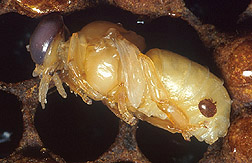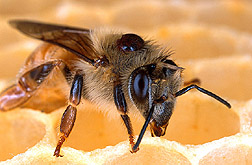Russian Honey Bee Earning Its Stripes
|
|
|
|
After a harsh winter, it looks to be a honey of a year for a sturdy breed of Russian bee that's helping U.S. apiarists fortify their hives against parasitic tracheal andVarroa mites.
"Last winter was one of the toughest we've had in the Midwest, and also in the South," notes Manley H. Bigalk, an apiarist in Cresco, Iowa. For winter-weakened hives, the mites' presence can be a costly, one-two punch. "Even with all the death-losses in domestic bees this past winter, this Russian was superb," says Bigalk, of Golden Ridge Honey Farms. He is one of three commercial apiarists who've been evaluating the Russian bees since 1999 in cooperation with Agricultural Research Service scientists at the Honey Bee Breeding, Genetics, and Physiology Research Laboratory in Baton Rouge, Louisiana. |
|
|
The program began in 1996, after ARS supervisory geneticist Thomas E. Rinderer traveled to a rugged stretch of land on Russia's Pacific coast called the Primorsky Territory.
Observing how well local honey bee hives fared despite parasitic mites and prolonged winters, Rinderer requested—and in July 1997 received—permission to import into the United States 100 queen bees from the region. After quarantined monitoring on Grande Terre Island, Louisiana, the Russian bees were moved to apiaries at ARS' Baton Rouge lab, where scientists subjected the Russian queens and their offspring to rigorous cycles of breeding, selection, and testing for mite resistance and other desired traits. In 1999 those efforts culminated in a cooperative research and development agreement with Bernard's Apiaries, Inc., of Breaux Bridge, Louisiana. Under the agreement, third-generation apiarist Steven S. Bernard is authorized to raise and sell pure-Russian breeder queen bees on a first-come, first-served basis. The breeder queens cost $500 each. From each of these, beekeepers breed thousands of production queens, which are placed in hives for pollination and honeymaking. Strict mating control of production queens is not done, so they sell for about $10 to $15 each. Although this year's domestic orders for Russian queens are about the same as last year's, Bernard reports high numbers of sales to European apiarists. Bernard decided to breed the Russian queens commercially after Rinderer approached him with the idea as a way to transfer the benefits of the ARS lab's research to U.S. apiarists. "I was reluctant at first because we had just gotten into producing and bottling honey," says Bernard. He had been breeding queens until a tracheal mite infestation in the late 1980s decimated his breeder stock. "When I realized I could still raise the breeder stock and make a living at it, the idea just appealed to me," he says. Although tracheal mites remain a problem, particularly in northeastern states,Varroa mites pose a broader threat to America's honey bees, whose pollination is worth $14.6 billion to U.S. agriculture. About 1 millimeter long, the reddishVarroa mites can kill or weaken adult and larval bees by sucking their blood or exposing them to diseases. Fluvalinate is one of two registered chemicals for controllingVarroa mites, whose attacks can otherwise destroy an entire hive within weeks or months. Cost, handling concerns, and the mite's ability to develop pesticide resistance have driven the search for alternatives. The best long-term solution for both domestic and feral honey bees, experts say, is to fortify them with mite-resistance traits—whether from Russian or other bee stock. "These mites are real good at building resistance, so we're looking at genetic approaches as a long-term solution," says Richard Adee, president of the American Honey Producers Association. "We're looking to cut down on the use of chemicals and chop away at the costs of using them." Backing that optimism is data from ARS' Baton Rouge lab. Studies there since 1997 show that mite reproduction levels are two to three times higher in domestic colonies than in Russian colonies. With lower mite counts comes less reliance on chemicals, notes Hubert D. Tubbs, an ARS cooperator who manages 3,500 honey bee colonies at Tubbs Apiaries in Webb, Mississippi. "My test yards are purebred Russian, and we haven't treated those colonies in 2 years," he reports. Other than the bees' diligent mite-grooming behaviors, "we don't know all of the mechanisms of resistance yet," says Rinderer. "In general, they differ from domestic bees in several small ways acting in concert." Since 1999, Bigalk, Bernard, and Tubbs have evaluated the bees' mettle against the mites, as well as their temperament, pollination habits, and honey production. Like Bigalk in Iowa, Tubbs had an opportunity to witness the Russian bees' durability thanks to a harsh winter. Of his 1,500 domestic colonies, 1,200 to 1,400 were lost, whereas of his 2,000 Russian-bred colonies, only 2 didn't survive. Based on test-yard evaluations, Tubbs reports average honey yields of 130 to 150 pounds per hive. The usual yield is about 84 pounds per hive. "This bee is a real nice bee. It's very hygenic, very gentle," Tubbs says. "Matter of fact, we pulled honey off them last year wearing shorts and T-shirts. They're excellent pollen gathers; they just hoard pollen." Bigalk suspects that a similar miserliness with honey also helps carry the bees through the winter better than domestic hives. Rinderer also attributes their "superior winter survival to being highly resistant to tracheal mites, something that's still uncommon for standard commercial colonies." Involved with the ARS program since it began, Tubbs and Bigalk both acknowledge that other apiarists may be more cautious about the breed's commercial potential, particularly if their hives aren't fully "Russianized." For Andrew L. Webb, of Calvert Apiaries near Mobile, Alabama, mite resistance is a lesser question than whether the bees will earn their stripes commercially. "I've got the Russians around mainly for their genetics," says the queen bee breeder. "But as to their honey production, the jury's still out on it," he adds. To find out, Webb teamed up with the ARS scientists this past summer to compare the Russians with an elite bee line and an English breed called Buckfast. Along with such evaluations, they'll continue importing Russian queens to further improve and diversify the existing bee stock, Rinderer says. Over the next 5 to 8 years, the goal is to furnish apiarists with up to 40 different, elite genetic lines of Russian queens. By using them sequentially, bee breeders can avoid inbred colonies. On a broader front, this will help ensure that the best of the Russian breed's traits reach the U.S. honey bee population in a uniform manner. "We originally got into the program to deliverVarroa mite resistance," says Rinderer. "But since Russian bees are also resistant to tracheal mites and are good honey producers and good winter survivors, the program is now focused on producing a stock improved for all these traits." Adds Bigalk, "We're seeing improvements in stock each year. One of the key points is that it's public stock. So it's something that anyone can easily work into their own program."—By Jan Suszkiw, Agricultural Research Service Information Staff. The research is part of Crop Production, an ARS National Program (#305) described on the World Wide Web at http://www.nps.ars.usda.gov. Thomas E. Rinderer, USDA-ARS Honey Bee Breeding, Genetics, and Physiology Research Laboratory, 1157 Ben Hur Road, Baton Rouge, LA 70820; phone (225) 767-9281, fax (225) 766-9212. |
|
"Russian Honey Bee Earning Its Stripes" was published in the October 2001 issue of Agricultural Research magazine. |
|








